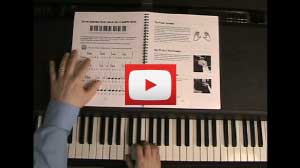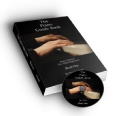How to Count Notes:
Get The Rhythm Right!
How to count notes. Sounds easy, right? Well, unfortunately it is the one thing that beginning music readers get seem to get wrong.
Not only do you have to play the right notes, but it is just as important to play the notes with the correct rhythm!
It's as easy as "one - two - three - four!"
When you learn to count notes, it helps tremendously if you count out loud! Counting out loud helps you focus on the notes and the rhythm timing. Most beginners will say "I'll count in my head," but after a measure or two, they've stopped counting, they have lost their concentration, and the rhythm falls apart.
We'll learn to count whole notes, half notes, quarter notes and sixteenth notes. We'll also learn what a dotted note is, and how to count dotted half notes and quarters.
Whole Notes

The whole note is held for the whole measure, for a total of four beats or counts. (In these examples where we learn to count notes, we will be using measures with a 4/4 time signature.)(More about the time signature)
The note above is "middle C." Press middle C down, and at the moment the note starts ringing, count "one, two, three, four." Lift up your finger after you say "four." For proper note counting, it is imperative that you keep a steady rhythm or beat, and don't go too fast!
Half Notes

Half notes receive two beats or counts. In the above example, press middle C on the count of "one," hold it down while you say "two;" lift and press again on the count of "three," holding it down until after you've said "four." (You'll find that it's easier to count notes than to read these directions!)
Quarter Notes

By now you should be getting the hang of it! Quarter notes get one beat. Keeping steady time, play middle C once for each number as you count "one, two, three, four."
Though it may seem very easy and "childish" or "silly" to count notes, don't let the simplicity of the act of counting diminish its importance! As they say, just do it!
Eighth Notes

Eighth notes are counted "one and two and three and four and." The eighth note divides the beat in half. When the music has eighth notes, it helps to count all of the "ands" in the measure, even if the notes are quarters, or halves. This ensures that all of the notes will be played in the right place, or at the right time.
For example a half note would be counted "one and two and;" pressing the note on "one," and holding down while you say "and two and."
Sixteenth Notes

There are four sixteenth notes per beat in 4/4 time. The above example is counted "one-e-and-ah, two-e-and-ah, three-e-and-ah, four-e-and-ah." Keep the sixteenth notes steady and evenly spaced.
Dotted Half Note

The dot after a note makes the note one and a half times longer in value. The dotted half note is held for three beats or counts. Press middle C on the count of "one," hold down until you press C again on the count of "four."
Dotted Quarter Note

The dotted quarter note is one and a half beats duration. It is often followed by an eighth note. Remember, that because there is an eighth note, we need to count all of the "ands." The dotted quarter is counted "one and two," and the following eighth note would be played on the next "and" (the "and" after "two").
Start Playing Piano Today with the Piano Guide Quick Start Course!
Easy to follow step-by-step lessons designed for adult beginners. The next best thing to private lessons!
What You'll Learn:
- Notes on the piano/keyboard
- Proper fingering
- C major scale
- Chords
- How to read music
- And much more!

Video lessons - watch as I play everything for you.

